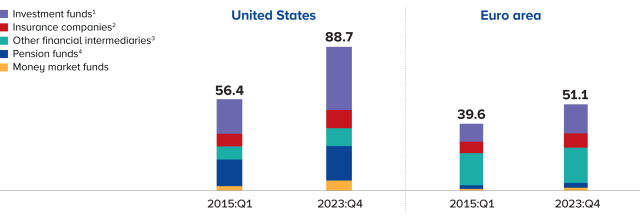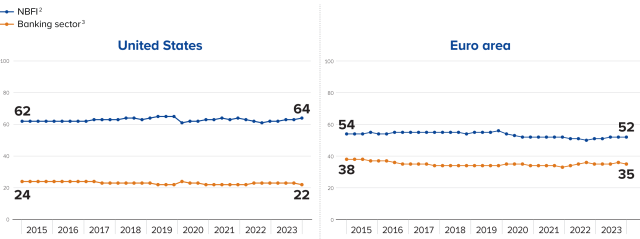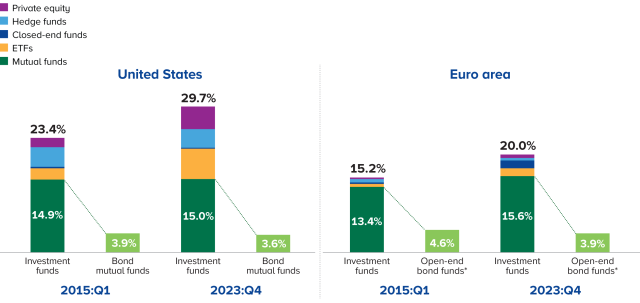ICI Viewpoints
Financial Policymakers Need to Look at the Facts About the “Growing Threat” of NBFI
Summary: Central bankers and finance ministries have increasingly equated the size and growth of the non-bank financial intermediation (NBFI) space with increased financial stability risks. Their rhetoric is not supported by data.
In absolute terms, NBFI has grown over the past decade, as have banks. In relative terms, banks and non-banks represent nearly the same proportion of total financial assets that they did almost a decade ago.
Further, while NBFI covers a wide array of entities, including some that are frequent users of leverage, central bankers and finance ministries have for several years focused on the growth of open-end bond funds to the exclusion of other types of NBFIs, even though such funds have posed little financial stability risk and continue to account for a very small part of the financial system. Open-end bond mutual funds represent a mere 3% to 4% slice of financial intermediation in both the United States and the Euro area, with these proportions little changed in nearly a decade.
Financial policymakers have long believed that size equals risk when it comes to banks. That assertion is debatable—a healthy, growing economy needs growing banks. Regardless, this simple reasoning hasn’t kept these policymakers from applying their size-equals-risk logic to financial intermediaries outside their regulatory purview, which they call “non-bank financial intermediaries” or NBFIs.
Recently, a European Central Bank Supervisory Board member expressed alarm to The Financial Times about the “remarkable” growth of NBFI, which she said “always worries us.” The newspaper characterized her remarks as calling out NBFI as “the biggest threat to the stability of the Eurozone’s financial system.”[1] Her statement echoes previous statements expressing concern about the growth of NBFI by officials at the International Monetary Fund, Financial Stability Board, and US Treasury Department.
Their thinking seems to go as follows: Since NBFI assets have increased, financial stability risks, particularly from asset management, have also increased. This five-alarm fire is further stoked by central bankers’ perception that NBFIs—entities that in their view have destabilizing liquidity mismatch, maturity transformation, and/or leverage and are generally regulated by agencies other than central banks—are conducting ever more financial intermediation at the expense of banks.
The data simply don’t bear this out.
NBFI has grown in absolute terms. Yet since early 2015, its share of total financial assets has remained remarkably steady. The absence of any disproportionate growth in NBFI—when appropriately scaled by a measure reflecting economic and financial market growth—begs the question of why policymakers continue to emphasize the increase in NBFI in absolute terms.
As Figure 1 shows, NBFI assets increased substantially over the past nine years in the United States (up 57%) and in the Euro area (up 29%).
FIGURE 1:
NBFI Assets in the United States and the Euro Area Have Increased in Absolute Terms…
Trillions of US dollars, euros

¹ Investment funds in the United States comprise the following entities: mutual funds (table L.122), closed-end funds (table L.123) and ETFs (table L.124) from the Federal Reserve Board’s Financial Accounts of the United States (flow of funds) and net assets of hedge funds and private equity funds from the Securities and Exchange Commission’s Private Funds Statistics (Form PF). Form PF data are as of 2023:Q3 (latest available). Investment funds in the Euro area comprise open-end funds (table IVF.TA), closed-end funds (table IVF.TB), ETFs (table IVF.TE), hedge funds (table IVF.50), and private equity funds (table IVF.TP) from Eurostat.
² Insurance companies in the United States comprise the following entities: property-casualty insurance companies (table L.115) and life insurance companies (table L.116) from flow of funds. Insurance companies’ holdings of money market funds (table L.115, line 3 and table L.116, line 3) and mutual funds (table L.115, line 13 and table L.116, line 15) are excluded because they are already accounted for in the investment funds category.
³ Other financial intermediaries in the United States comprise the following entities: issuers of asset-backed securities (table L.127), finance companies (table L.128), REITs (table L.129), security brokers and dealers (table L.130) and other financial business (table L.132) from flow of funds. Other financial intermediaries in the Euro area comprise other financial intermediaries (table s125) and captive financial institutions and money lenders (table s127) from Eurostat.
⁴ Pension funds in the United States are private and public pension funds (table L.117) from flow of funds. Pension funds’ holdings of money market funds (table L.117, line 4) and mutual funds (table L.117, line 16) are excluded because they are already accounted for in the investment funds category.
Sources: ICI calculations of data from Eurostat, Federal Reserve Board, and Securities and Exchange Commission
But is non-bank financial intermediation increasingly becoming a much bigger part of the financial system? No.
Central bankers and other policymakers routinely describe the increase in NBFI assets in absolute rather than relative terms. While they are correct that NBFI assets have grown and NBFI assets are larger than banks’, Figure 2 shows that when scaled by total financial assets, their relative proportions haven’t changed much at all in nearly a decade. In the United States, NBFI accounted for 64% of total financial assets at the end of 2023, up only 2 percentage points from early 2015. In the Euro area, NBFI’s share has even declined marginally, from 54% to 52%. At the same time, banks’ share of total financial assets in both regions is also little changed since 2015.
FIGURE 2:
...But Represent a Relatively Steady Share of Total Financial Assets
Percent of total financial assets1, quarterly

¹ Total financial assets in the United States comprises total financial assets of domestic financial sectors (table L.108) less insurance companies’ and pension funds’ holdings of money market funds and mutual funds from flow of funds plus hedge funds and private equity funds from Form PF. Total financial assets in the Euro area comprise total financial assets of financial corporations (table s12) less investment funds (table s124) plus investment funds (table IVF. T0) from Eurostat.
² NBFI closely follows the FSB definition and includes the following entities: money market funds, investment funds, other financial intermediaries, pension funds, and insurance companies.
³ Banking sector in the United States comprises private depository institutions (table L.108) and holding companies (table L.131) from flow of funds. Banking sector in the Euro area comprises monetary financial institutions less central bank assets and money market funds from Eurostat.
Sources: ICI calculations of data from Eurostat, Federal Reserve Board, and Securities and Exchange Commission
The story does not end there. Policymakers frequently describe non-bank financial intermediation as a monolithic concept. ICI has long been concerned that policymakers associate NBFI in their work programmes almost exclusively with retail-focused investment funds, like open-end mutual funds and ETFs.[2]
NBFIs comprises a range of entities with different business models. For example, in the Euro area, “other financial institutions,” which includes captive financial and money lenders, contribute about the same to NBFI assets as do investment funds. In the United States, pension fund and insurance company assets account for a sizeable chunk of NBFI assets.
And within the category of investment funds, there is a menagerie of different types of funds. The category includes a range of pooled investment funds (e.g., open-end mutual funds, hedge funds, ETFs, closed-end funds, and private equity funds) that vary widely by size, business models, risk and return profiles, and investor clienteles (Figure 3).
When pushed, central bankers will often say they are only (or mostly) concerned about investment funds that intermediate credit and in their view engage in significant “liquidity transformation” or use leverage.
This intersection of credit intermediation and liquidity transformation leads central bankers in Europe and the United States to express concern specifically about open-end bond funds. They claim to be worried that they have become so large as to cause financial markets to freeze up in a stress event and, therefore, believe they must be constrained.[3] ICI has raised serious questions about these theories by providing data demonstrating that open-end bond mutual funds in the US had little impact on the bond markets during the liquidity crisis of March 2020.[4]
If policymakers want to keep a close eye on the growth of open-end bond funds, they should size them appropriately and scale by total financial assets. Figure 3 shows that open-end bond funds accounted for between a mere 3% and 4% of total financial assets in the United States and the Euro area at the end of 2023.[5] That proportion has dipped slightly in the past nine years even as the share of investment funds as a whole has increased. It’s important to note that the higher share that investment funds now represent of total financial assets has been driven by growth in vehicles—ETFs and private equity in the United States and ETFs, closed-end funds, and non-bond open-end funds in the Euro area—that policymakers themselves say are less vulnerable to financial stability risks because they don’t intermediate credit or have significant liquidity mismatch.
FIGURE 3:
Zooming In on Investment Funds Highlights That Open-End Bond Funds Represent a Small Slice of Financial Intermediation
Percent of total financial assets

*Open-end bond funds comprise open-end UCITS and non-UCITS bond funds.
Sources: ICI calculations of data from Eurostat, Federal Reserve Board, Investment Company Institute, and Securities Exchange Commission
To be clear, we support policymakers making a proper assessment of build-ups in financial stability risk and acting accordingly. The challenge they face is in finding the right balance between embracing NBFI as an important component of robust capital markets and developing appropriate guardrails around burgeoning financial stability risk. An appropriate use of data is all-important in that discussion. Otherwise, policymakers are likely to misallocate their attention and create blind spots for themselves. To this end, we believe their singular focus on open-end mutual funds—which are one of the most highly regulated and transparent investment vehicles in the financial system—is misguided. Open-end mutual funds should not face greater regulatory burdens because of policymakers’ unfounded fears and inadequate analysis.
Notes
[1] Financial Times: “Top ECB official sounds alarm on rising risks from shadow banking”, July 10, 2024
[2] See E. Pan, “Financial Stability Board Should Rethink Its Agenda on Non-Bank Financial Intermediation,” ICI Viewpoints, February 16, 2023.
[3] For example, see the ECB’s Financial Stability Review, November 2023, and the IMF’s April 2024 Global Financial Stability Report.
[4] See, S. Antoniewicz and S. Collins, “ICI Bond Mutual Fund Survey Brings Facts to the Debate,” ICI Viewpoints, February 24, 2022; “Setting the Record Straight on Bond Mutual Funds’ Sales of Treasuries,” ICI Viewpoints, February 24, 2022; “Policymakers Say Bond Mutual Funds Contributed Significantly to Treasury Market Stress but...,” ICI Viewpoints, March 24, 2022; “Policymakers Need to Focus on Economic Fundamentals and Not Blame Bond Mutual Funds: Examining the Evidence of Investment Grade Corporate Bond Yield Spreads in March 2020,” ICI Viewpoints, July 6, 2022; “Core Bond Mutual Funds Had Little Impact on the Investment Grade Corporate Bond Market,” ICI Viewpoints, August 4, 2022.
[5] This is an upper estimate since the figures combine corporate and sovereign debt bond funds in the category open-end bond funds. Given that corporate bond funds are a subset of open-end bond funds, the actual proportion of total financial assets will be much lower.
Shelly Antoniewicz is the Deputy Chief Economist at ICI.
Shane Worner is a Senior Economist at ICI.
